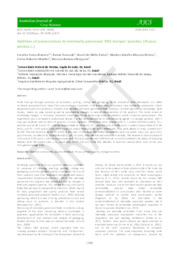Addition of preservatives to minimally processed "BRS Kampai" peaches (Prunus persicaL.).
Addition of preservatives to minimally processed "BRS Kampai" peaches (Prunus persicaL.).
Resumo: Fruits that go through processes of sanitation, peeling, cuttingand packaging,to be consumed soon afterwards, are called minimally processed fruits.Since fruit consumption is important in the human diet, consumers have looked for practicality in both preparation and consumption, a situation that includes minimally processed food. However, minimal processing can damage plant tissues, mainly by pulp browning and by accelerating changes in natural characteristics of the product. This study aimed at minimizing changes in minimally processed sliced peaches by immersing them in solutionswhich contained preservatives.The experiment was a completely randomized design in a 5x3 factorial scheme (5 anti-browning agents x 3 storage periods), with 4 trays per replicateand six slices of peaches in every replicate.Sliced fruits were treated with T1 = control (distilled water); T2 = ascorbic acid at 1% (m/v); T3 = sodium isoascorbate at 1% (m/v); T4 = ascorbic acid at 0.5% (m/v) + sodium isoascorbate at 0.5% (m/v); and T5 = citric acid at 0.5% (m/v)+ sodium isoascorbateat 0.5% (m/v). Afterwards, they were placed on trays, covered with 9? PVC film and stored at 4±1ºC for 0(S1), 6(S2)and 12 (S3) days. The following variables were evaluated: mass loss, pulp color, pulp firmness, soluble solids, titratable acidity, pH, rot spots, total phenols and antioxidant activity. The treatment that consisted of citric acid at 0.5% (m/v) + sodium isoascorbateat 0.5% (m/v) was the most efficient one to controloxidation; its values of browning indexes were the lowest ones, i. e.,15.62 (S1), 17.74 (S2) and 17.58 (S3).Besides, it kept the creamy-white color of the pulp throughout storage time.
Ano de publicação: 2020
Tipo de publicação: Artigo de periódico
Unidade: Embrapa Clima Temperado
Palavras-chave: Fruticultura, Processamento Mínimo, Pêssego
Observações
1 - Por padrão são exibidas publicações dos últimos 20 anos. Para encontrar publicações mais antigas, configure o filtro ano de publicação, colocando o ano a partir do qual você deseja encontrar publicações. O filtro está na coluna da esquerda na busca acima.
2 - Para ler algumas publicações da Embrapa (apenas as que estão em formato ePub), é necessário ter, no celular ou computador, um desses softwares gratuitos. Sistemas Android: Google Play Livros; IOS: iBooks; Windows e Linux: software Calibre.
Acesse outras publicações
Acesse a Base de Dados da Pesquisa Agropecuária (BDPA) para consultar o acervo completo das bibliotecas da Embrapa.

